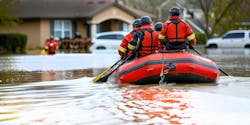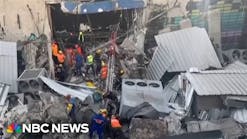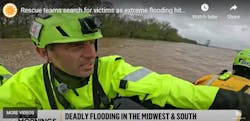The “City of New Orleans” Amtrak passenger train was linked with Kankakee, Bourbonnais’ neighbor to the south, in the Steve Goodman song sung by Arlo Guthrie. Providing overnight sleeper service, the train begins its southward trip in Chicago and heads through Memphis, TN, toward the Gulf of Mexico. Many times, it carries college students returning to schools in Carbondale and Champaign, IL, but that night the students were away on spring break.
On this trip the 14-car train was being hauled by two locomotives and carried 214 passengers. But the train never made it to its destination that night; instead, it came to a dead stop as though it had hit a brick wall at 9:47 P.M.
John Stokes, a trucker from nearby Manteno, had just loaded his flatbed trailer with rebar steel at a nearby Birmingham Steel plant and was crossing the McKnight Road crossing when the Amtrak train clipped the end of his trailer bed at 79 miles per hour. While the initial impact was enough to derail the train, the engine then slammed into a hopper car loaded with 90 tons of steel waste that was sitting on the next track. The cars toppled into each other, spilling back and forth to the east and west of the tracks like dominos. The 2,200 gallons of diesel fuel that was leaking from the second engine and friction from the crushing metal caused flames to break out, engulfing the 156,605-pound sleeper car. The sleeper had “T-boned” the derailed engine, nearly splitting in two, trapping its victims. Into the sleeper crashed the dining car and other coach units. All but three cars derailed in the incident. The truck received little damage and the bed was still connected to the cab at the crossing. The driver was transported to the hospital for minor injuries.
passengers trapped
The disaster occurred in just a few seconds. The sound of the impact led workers at the nearby steel plant to think that it happened in the melt shop, where a loud “boom” occurs when cold water hits hot metal. While a guard called 911, about a dozen workers grabbed flashlights to run toward the screams of the trapped victims. They immediately began to enter the two most heavily damaged cars – the sleeper and dining car, helping victims to safety. Despite the fire and the hot metal of the derailed train, they were determined to stay and help the people on the train. Victims were first put in a nearby work trailer; when it was full, they began to gather in the plant’s office and even the plant itself just to stay out of the cold. Many tumbled out wearing just their nightgowns with no shoes, as they were ready to be rocked to sleep by the gentle beat of rolling train.
The Bourbonnais Fire Protection District covers about 60 square miles and protects about 30,000 people. Its roster includes 39 paid-on-call members, of which one is a full-time administrative officer. Its members answer about 1,800 fire and ambulance calls annually. The 19,000-square-foot station houses three pumpers, two tankers, a rescue squad, two advanced life support (ALS) ambulances, a brush truck and two cars for the night duty and administrative officers. Members take pride in their training and in their modern, well-kept equipment. Both traits benefitted them that night.
The station was being staffed at that time by two personnel, but they were busy with an ambulance call to aid a teenager with a pitchfork in his foot. Three other personnel were just leaving that call to hear the second page of “Ambulance needed for a train-versus-truck incident at the Birmingham Steel facility.”
Bourbonnais Police Officers Justin Goselin and Dave Verkler immediately raced to the scene. Their first glance at the tumbled railcars told them to have the village dispatch notify the fire department of a “5-11” alarm, which would send units from throughout Kankakee County and from nearby Will County to the scene. (The communications system in place does not permit police to speak directly to the fire department, but rather to communicate through their common dispatch.)
command established
Fire Lieutenant John Dunlavey, that night’s duty officer, responded to the east side of the tracks while Chief Mike Harshbarger and Firefighter Dan Allen went on the frontage road between the steel plant and the railroad tracks on the west side. Even in the darkness, from the tons of bent steel and roaring flame shooting up in the night sky it was obvious that they could expect many injuries and even fatalities.
Harshbarger agreed with the call for a 5-11 alarm, then immediately became the incident commander and established command on the west side. Squad 62’s tank of 500 gallons of water barely had an effect on the massive amount of flames. The crew immediately headed toward the diner and sleeper to search for the approximately 40 to 50 passengers inside the two cars. In a totally black environment, they could feel the heat as the tipped-over engine laid under the sleeper.
Harshbarger asked front-line Engine 61 to report to the west side. Before entering the frontage road, the engine dropped its connection at a hydrant on Larry Power Road. Because it carried only 2,000 feet of five-inch hose, it relied on its neighbor, Bradley, to finish completing the half-mile of hose lay. The crew of Engine 61 pulled two 21¼2-inch lines from the pumper, quickly coming close to draining the 1,000-gallon tank. The Bradley engine began to feed the front-line pumper and, when depleted, Engine 61 received 3,500 gallons from a Bourbonnais tanker.
Although a tanker box alarm had been called, the situation was not very conducive to a tanker operation. Tanker 65 soon found itself blocked in and unable to return in any direction. Engineer Mileen Joines found herself with four lines out, with one using foam from the Bourbonnais rescue truck. Finally, the five-inch hose filled with water. One hoseline broke during operation, and it took firefighters a few minutes to gate all lines down to keep water flowing in all directions. A foam truck was brought in from nearby Braidwood to help extinguish the determined flames. With no pressure left, it was again an attempt to have a pumper stop at the hydrant and provide extra pressure. Finally accomplished, the foam truck quickly controlled the fire. With more than 100 pieces of apparatus from over 60 agencies, Harshbarger quickly commanded some of the 338 personnel to continue search and rescue operations in all of the cars.
medical response
Although Harshbarger and his crews on the west side were the main command center, the east side had its own triage and medical sectors. Clerks at a nearby department store had been taking inventory at the time of the accident and immediately opened the store to become a triage and warming area for the train’s passengers. The employees told EMS personnel to “take whatever you need,” and soon blankets, towels and socks were being handed out to the victims. Medical teams from the nearby St. Mary’s and Riverside Medical Center trauma centers responded, as did helicopters from Loyola University Medical Center in Maywood and the University of Chicago. One passenger was flown to Loyola for extensive burns.
All of the 112 passengers who were treated at nearby hospitals arrived by 11 P.M. Hospital crews met each ambulance with a bed, enabling paramedics to quickly move the patients and rush back to the scene for the next transfer. All passengers treated at the scene or in hospitals survived.
Uninjured passengers were transported to a nearby school building, the Bourbonnais Upper Grade Center, to await word about loved ones. Immediately upon hearing of the incident, teachers and other civilians, with the help of the American Red Cross and the Salvation Army, sped to the school to try to help those in need. Most had no medical training and when asked what they should do, were told to just listen and comfort. Buses arriving from hospitals brought everyone to their feet to see whether their loved ones were safe.
Eleven families never found their loved ones that night. The victims’ ages ranged from 8 to 76, and their homes from Chicago to Mississippi to Washington to Japan. Four victims were killed by fire and one died from the effects of carbon monoxide. The six remaining victims died of crash injuries caused by debris and a part of a train track that speared the middle of the sleeper car.
A half dozen lives were saved through the use of a thermal imaging camera that had recently been purchased for the Bourbonnais Fire Department through a community fund-raising effort.
disaster scene
Daybreak provided an entirely new picture of the scene. For the first time, the rescuers could see the massive destruction, and they felt very small walking amid the tons of twisted steel, still searching for victims. Every car was searched and searched again, as there still remained hope of finding someone still alive. After it was learned that several passengers had wandered away after the crash, rescuers determined that all remaining victims had to be in the “bend” where the burned sleeping car had come in contact with the engine. It was there that the remaining bodies were found.
With officials from the National Transportation Safety Board (NTSB) arriving at the scene that morning, responsibility was transferred from Harshbarger. Heavy equipment was brought in to pull the train cars away from each other and to keep the scene as safe as possible. All rescuers donned hazardous materials suits. Any human parts or any of the passengers’ personal items, such as a billfold or shopping bag, were tagged for location to assist the coroner.
Word of the incident quickly brought members of the news media to the scene in droves. The village had never attracted such attention, nor had such large antennas looming over it. Reporters were interested in every facet of the incident, staging themselves at the fire department, hospitals, the school and motels where family members were staying.
Lessons were learned that night, not only by the Bourbonnais Fire Department, but by the entire county. The area realized how much it needed to upgrade its communication system, enabling all facilities to speak directly to each other. Some communications problems occurred during the incident, largely because of the large number of radio transmissions from various areas of the scene. Officials also recognized a need to pre-plan utilization of their low-band frequencies. During the incident, some officers resorted to “face-to-face” communications or sending “runners” to transmit necessary information.
The water supply also was an issue. The fire department had a large amount of five-inch hose to utilize, but with the overwhelming situation and massive number of radio transmissions and telephone calls fielded by the personnel in the department’s radio room, the hydrant connection was not made as soon as it could have been.
Both the fire department and Amtrak realized a need to improve the tracking of passengers. Initially, Amtrak could not tell the fire department the exact number of passengers on the train; it could only estimate that the number was between 200 and 400. Area hospitals, fearing the worst, alerted hospitals in the southern suburbs, which in turn called in their trauma teams. The fear of a great more dead than the actual number escalated the anxiety the rescue teams felt that night. Amtrak stated it had no way of knowing how many were on the train because “a ticket sold did not necessarily mean the passenger rode that night or who that person may be.” Also, tickets could be purchased for an entire group, all under the only purchaser’s name. The exact number still missing was not confirmed until the morning hours.
The area had never had such massive coverage from the media. Members of the fire department, police and village officials soon found themselves in front of many cameras, giving out details and opinions and being asked difficult questions. Officials of all the participating departments, along with the NTSB and Amtrak, worked well to keep each other informed of findings. The media were also informed as soon as it was seemed appropriate.
The county has conducted a mass-casualty disaster drill on a yearly basis, inviting all agencies to participate. Always informative, everyone felt after the Amtrak incident that these drills would be completed with more intensity in the future.
Eleven people lost their lives that night. Only one firefighter was treated for smoke inhalation. There could have been many more fatalities and many more injuries. Training, cooperation and a will to help others paid off on the dreadful night of March 15, 1999.
Mileen M. Joines is a 14-year veteran of the Bourbonnais, IL, Fire Department, presently as an engineer/EMT-ID. She is a state-certified Firefighter III and Fire Apparatus Engineer.




